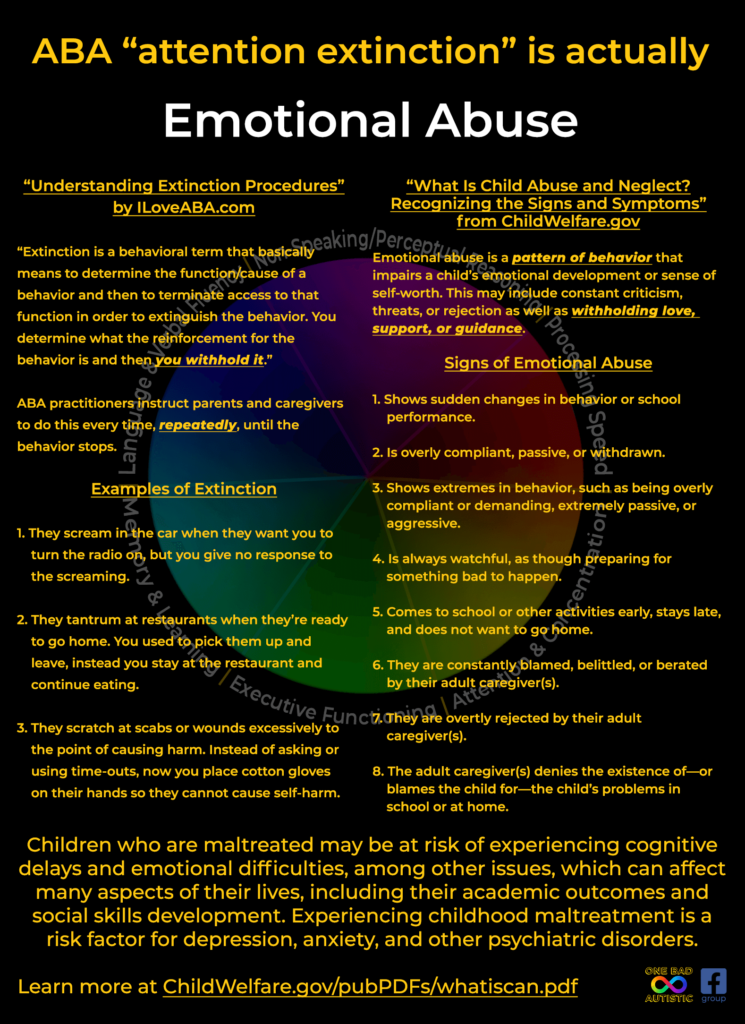A red flag when looking for a therapist for your autistic child is if they use techniques like planned ignoring or attention extinction. Many therapists for autistic children offer Applied Behavior Analysis (ABA) and manipulative procedures like attention extinction can cause more harm than they do good. Let’s explore the unethical science behind this evidence-based practice and why autistic advocates claim it is abuse.
This infographic compares the definitions and examples of extinction in regards to behavioralism to the definition and signs of emotional abuse.
I also want to remind you that you are not a bad parent or caregiver if you ignore your child. It only becomes abuse when it is your “go-to” tool in your parenting toolbox or is used often. Being ignored once in a while may just hurt your feelings. Being ignored all the time is neglectful. Frequency matters.
I created this infographic for the One Bad Autistic Facebook group’s learning units/guides on Applied Behavior Analysis and how and why it’s harmful.
Infographic Description & Transcription
The image itself has alt-text for screen-readers, but if you want to share this image on social media, please copy/paste the text below.
Image Description: An infographic with a 2-column layout comparing the definition and examples of ABA's "attention extinction" procedure in the first column to the definition and signs of emotional abuse in the second column. Image Transcription: ABA "attention extinction" is actually emotional abuse. "Understanding Extinction Procedures" by ILoveABA(dot)com “Extinction is a behavioral term that basically means to determine the function/cause of a behavior and then to terminate access to that function in order to extinguish the behavior. You determine what the reinforcement for the behavior is and then you withhold it.” ABA practitioners instruct parents and caregivers to do this every time, repeatedly, until the behavior stops. Examples of Extinction 1. They scream in the car when they want you to turn the radio on, but you give no response to the screaming. 2. They tantrum at restaurants when they’re ready to go home. You used to pick them up and leave, instead you stay at the restaurant and continue eating. 3. They scratch at scabs or wounds excessively to the point of causing harm. Instead of asking or using time-outs, now you place cotton gloves on their hands so they cannot cause self-harm. “What Is Child Abuse and Neglect? Recognizing the Signs and Symptoms” from ChildWelfare(dot)gov Emotional abuse is a pattern of behavior that impairs a child’s emotional development or sense of self-worth. This may include constant criticism, threats, or rejection as well as withholding love, support, or guidance. Signs of Emotional Abuse 1. Shows sudden changes in behavior or school performance. 2. Is overly compliant, passive, or withdrawn. 3. Shows extremes in behavior, such as being overly compliant or demanding, extremely passive, or aggressive. 4. Is always watchful, as though preparing for something bad to happen. 5. Comes to school or other activities early, stays late, and does not want to go home. 6. They are constantly blamed, belittled, or berated by their adult caregiver(s). 7. They are overtly rejected by their adult caregiver(s). 8. The adult caregiver(s) denies the existence of—or blames the child for—the child’s problems in school or at home. Children who are maltreated may be at risk of experiencing cognitive delays and emotional difficulties, among other issues, which can affect many aspects of their lives, including their academic outcomes and social skills development. Experiencing childhood maltreatment is a risk factor for depression, anxiety, and other psychiatric disorders. Image Credit: One Bad Autistic, Facebook Group Image Source: https://just1voice.com/neurodiversity/autism/attention-extinction-in-applied-behavior-analysis/
Sources
- Child Welfare Information Gateway. “What is Child Abuse and Neglect? Recognizing the Signs and Symptoms” (Apr. 2019). Children’s Bureau/ACYF/ACF/HHS. U.S. Department of Health & Human Services.
- Tameika Meadows, “Understanding Extinction Procedures” (Dec. 2011). I Love ABA!

